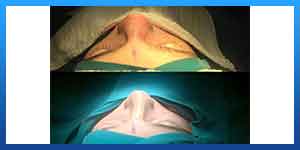Rhinoplasty surgery

Rhinoplasty surgery Steps
What are the steps of a rhinoplasty surgery?
Here are 6 steps that most Rhinoplasty Surgeons follow during the surgical procedure. A typical Rhinoplasty procedure commonly consists of the following steps:
. Step 1 - Anesthesia
Medications are administered for your comfort during the surgical procedure. The choices include intravenous sedation or general anesthesia. Intravenous sedation numbs the specific area of the surgery and the patient is often given IV sedation in combination with local anesthesia to help them relax during the surgery process. A general anesthesia may also be used during the rhinoplasty procedure, which puts the patient into a deep sleep. Your doctor will recommend the best medication for your specific needs.

Read more about : Rhinoplasty surgery before and after
Read more about : Nose job simulator
Read more about : Signs of infection after rhinoplasty
. Step 2 - The Incisions
The incisions used for a rhinoplasty vary based on whether the procedure is open or closed. In an open rhinoplasty, the incisions are made across the columella, the stip of tissue that separates the nostrils. This procedure is generally considered more invasive and is reserved for major surgeries. A closed rhinoplasty involves hidden incisions inside the nose, and is used for smaller adjustments to the shape of the nose. Through these incisions, the skin that covers the nasal bones and cartilage is raised, allowing access to shape the structure of the nose.
. Step 3 - Monitoring
Throughout the procedure, your doctor may monitor certain vital signs like your breathing rate and blood pressure, to ensure your body is handling the procedure properly. These monitors are for the patient’s well-being and rarely anything to be worried about.
. Step 4 - Reshaping the Nose Structure
Once the incisions have been made, the doctor can perform the process of reshaping the nose in accordance to what was discussed with the patient prior to the surgery. A large nose may be reduced by removing bone or cartilage. Sometimes surgery may require the addition of cartilage, most commonly, the septum, the partition in the middle of the nose, is used for this purpose, and occasionally cartilage from the ear or rarely a section of rib cartilage can be used as well. If the septum is deviated, it can be straightened and the protrusions inside the nose can be reduced to improve breathing.
Read more about : Deviated septum surgery
. Step 5 - Closing the Incisions
Once the structure of the nose is sculpted to the desired shape, the doctor will close the incisions with little stitches. Additional incisions may be placed in the creases of the nostrils to alter their size. A splint is usually applied to keep the nose in place as it heals, and to protect it from accidental trauma, some patients might also have internal splints or tubes as well. The patient is then taken to a recovery area to be monitored for a short period of time after surgery, to ensure the patient's vitals stay regulated until it's safe to go home.
Some patients remain in the hospital overnight for observation, while most patients are allowed to go home after surgery within a few hours. Patients should have been instructed by their doctor before the surgery, to have someone ready to pick them up after the short recovery period afterwards. You will not be able to drive yourself home after undergoing a rhinoplasty procedure, because you will likely feel nauseous, tired, and uncomfortable immediately after surgery.
Step 6 - Post-Rhinoplasty Recovery
Patients should expect to experience swelling, bruising, bleeding, and a light headache for the first few days following their procedure. Pain medication will be prescribed by your doctor to help minimize the discomfort after your surgery.
Additionally, any sutures and packing will be removed during your post-operative examination, which usually takes place seven to ten days after the surgery. Strenuous activity should be avoided for a minimum of two weeks.
Patients should also refrain from wearing cosmetics for up to two weeks, as to not disturb the skin around the affected area. Eyeglasses should not be worn for up to six weeks following your procedure, to protect your nose from deviations in the nasal bone resulting in needing a revision rhinoplasty. The healing process after a rhinoplasty takes some time, some patients may not see the full benefits of the procedure for up to one year. During this time you will notice gradual changes in the appearance of your nose structure.
What is Rhinoplasty?
Rhinoplasty also known as nose reshaping or nose job is surgery that changes the shape of the nose. The motivation for rhinoplasty may be to change the appearance of the nose, improve breathing or both. In Other words, Rhinoplasty can change the size, shape or proportions of your nose. It may be done to repair deformities from an injury, correct a birth defect or improve some breathing difficulties.
Type of Rhinoplasty
What are the different types of rhinoplasty?
- Open Rhinoplasty
An open rhinoplasty is used to treat the nasal tip and middle portion of the nose. It involves the use of a small bridging incision to link incisions to the right and left nostrils. The bridging incision allows the nasal skin to be folded upward, thereby providing full access to the lower nasal skeleton.
Open rhinoplasty is generally recommended in situations where patients display the following characteristics:
. Thick or thin nasal skin
. Septal perforations or a deviated nasal septum
. Cleft lip and palate involving the nose
. Nasal tumors
. Failure of an earlier rhinoplasty procedure, whether open or closed
. Internal dysfunction of nasal structures
. Extensive augmentations to the various structures of the nose, especially internally
A closed rhinoplasty is the most common type of rhinoplasty. All incisions are hidden inside the nose with no external scars. Lifting the soft tissue slightly upward, the bone and cartilage is accessible to perform the necessary changes.
Closed rhinoplasty is suitable for any type of nose surgery depending on the surgeon’s skill. If this is your first operation, closed rhinoplasty is likely to be recommended. Closed rhinoplasty is an effective method for patients who are opting for simple surgery to thin the nose or remove lumps or bumps, rather than having work done on the tip. Moreover, closed rhinoplasty is suitable for those who need small changes to their nose and want to heal faster.
A nonsurgical rhinoplasty also called “liquid nose job” or “15-minute nose job.” is actually a dermal filler procedure that changes the shape of your nose for up to 6 months.
This procedure is ideal for people who are looking to smooth out bumps in their nose or make it look less angular but who aren’t ready for a permanent solution, or are worried about the risks and recovery time involved in a traditional rhinoplasty.
Going under the needle is certainly less complicated than going under the knife for a nose job, but modifying the nose’s shape is never risk-free.
Revision rhinoplasty is a surgical procedure to repair form and function of the nose after an inappropriate nose surgery (bad rhinoplasty). The demand for the secondary surgery is high, due to the fact that rhinoplasty is one of the most difficult plastic surgeries. After initial (primary) rhinoplasty surgery, patients may be unsatisfied with the appearance of their nose or have difficulty in breathing, or both.
As a secondary surgery to correct primary rhinoplasty, revision rhinoplasty can be even more complicated procedure compared to initial one. For patients who need revision rhinoplasty to fix the problems of previous nose surgery, it is essential to find a rhinoplasty surgeon who is qualified enough, experienced and knowledgeable which are the main features of our surgeons.
Read more about : Crying after rhinoplasty
Read more about : When can i touch my nose after rhinoplasty?
Read more about : How long should i tape my nose after rhinoplasty?
- Rhinoplasty in Iran
- Rhinoplasty in Iran cost
- Revision Rhinoplasty in Iran
- Closed Rhinoplasty in Iran
- Open Rhinoplasty in Iran
- Before Rhinoplasty in Iran
- During Rhinoplasty in Iran
- After Rhinoplasty in Iran
- The common methods used in rhinoplasty in Iran
- Flying after Rhinoplasty in Iran
- Risks of Rhinoplasty in Iran
- Steps of Rhinoplasty in Iran
- Cleaning outside of nose after Rhinoplasty in Iran
- Best age for Rhinoplasty surgery
- Rhinoplasty Recovery
- Features of a good Rhinoplasty surgery in Iran
- Infective complications related to Rhinoplasty surgery
- Plastic surgery in Iran
- Rhinoplasty
- Face lift
- Facial plastic surgery
- Lip augmentation
- Ear pinning
- Blepharoplasty
- Neck lift surgery
- Chin lift surgery
- Liposuction
- Abdominoplasty (tummy tuck)
- Body sculpting
- Arm Lift
- Brazilian Butt Lift
- Breast Augmentation
- Breast Lift
- Breast implant
- male breast reduction ( gynecomastia )
- sex reassignment surgery ( sex change )
- Vaginoplasty
- labiaplasty
- Hair transplant for male
- Female hair transplant
- Reconstructive surgery
- Septoplasty
- Breast reconstruction
- Breast reduction
- Cleft lip and palate repair

